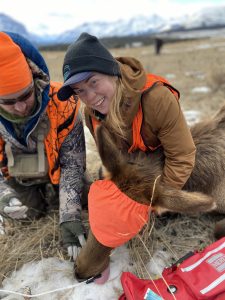My research focuses on winter behaviour of the Ya Ha Tinda (YHT) elk herd near Banff National Park (BNP) in Alberta. Historically, 90% of the elk migrated westward to summer in BNP; now, 65% of the elk have become residents of the winter range year-long. Despite more favourable summer range conditions, differences in habitat use and foraging behaviour on the sympatric winter range may affect the decline in western migrants. Human-habituated resident elk use YHT ranch infrastructure as a predator refuge to reduce foraging costs of  vigilance and form larger groups than western migrants, contributing to their success. Recently, a new migratory segment has emerged with ~60% of the elk that migrate moving east to summer on low-elevation, industrial timber lands. The differences in behaviour of these eastern migrants compared to residents and western migrants is not well understood, and may explain the recent success of this herd segment. The purpose of this study is to contrast the behavioural differences of the three migratory herd segments on their sympatric winter range, which may affect survival. Using field observations and GPS collar locations from tagged female elk, I will study habitat use, vigilance patterns, and group behaviour of the three different herd segments to address 3 hypotheses: 1) eastern migrants are excluded by residents to poor quality habitat in winter, 2) residents will have larger, more cohesive winter groups, and show less foraging interference than migrants. 3) Migrant elk show more vigilance for predators and humans than resident elk with a subsequent foraging cost as a trade-off. Focusing on these three migratory segments will further our understanding of how migration influences elk behaviour and affects overall population trends.
vigilance and form larger groups than western migrants, contributing to their success. Recently, a new migratory segment has emerged with ~60% of the elk that migrate moving east to summer on low-elevation, industrial timber lands. The differences in behaviour of these eastern migrants compared to residents and western migrants is not well understood, and may explain the recent success of this herd segment. The purpose of this study is to contrast the behavioural differences of the three migratory herd segments on their sympatric winter range, which may affect survival. Using field observations and GPS collar locations from tagged female elk, I will study habitat use, vigilance patterns, and group behaviour of the three different herd segments to address 3 hypotheses: 1) eastern migrants are excluded by residents to poor quality habitat in winter, 2) residents will have larger, more cohesive winter groups, and show less foraging interference than migrants. 3) Migrant elk show more vigilance for predators and humans than resident elk with a subsequent foraging cost as a trade-off. Focusing on these three migratory segments will further our understanding of how migration influences elk behaviour and affects overall population trends.
Congratulations to Maddie Trottier for the successful completion of her MSc. degree. Maddie’s defense entitled, “Disparity in conspecific interaction and vigilance behaviour in a partially-migratory elk herd (Cervus canadensis) on a sympatric winter range” was on June 9, 2022.
Funding Agencies:
NSERC
Safari Club International Northern Alberta Chapter
Alberta Conservation Association
Awards:
Alberta Graduate Excellent Scholarship Award (2020)
Canada Graduate Scholarship Master’s Program (NSERC) 2020
Walter H. Johns Graduate Scholarship (University of Alberta) 2020
SCI-NAC Hunting Heritage Grant 2019
ACA Biodiversity Grant 2019
Presentations
2022
Thesis defence – Disparity in conspecific interaction and vigilance behaviour in a partially-migratory elk herd (Cervus canadensis) on a sympatric winter range, June 9, 2022.
2020
Trottier M, Merrill E, Hebblewhite M. Disparity in elk (Cervus canadensis) movement and behaviour following different migratory tactics on a sympatric winter range. Poster presentation, 2020 Alberta Chapter of The Wildlife Society, online (https://www.actws.ca/).
2019
Trottier M, McPhee D, Normandeau J, Hebblewhite M, and Merrill E. Disparity in elk (Cervus canadensis) behaviour following different migratory tactics on a sympatric winter range. Poster presentation, 2019 World Mountain Ungulate Conference, Bozeman, Montana
McPhee D, Trottier M, Normandeau J, Merrill E. Winter behaviour of a new migratory strategy: Ya Ha Tinda elk herd. Poster presentation, 2019 Alberta Chapter of the Wildlife Society, Canmore, Alberta.
Publications:
Merrill E, Killeen J, Pettit J, Trottier M, Martin H, Berg J, Bohm H, Eggeman S, Hebblewhite M. 2020. Density-dependent foraging behaviours on sympatric winter ranges in a partially migratory elk population. Front. Eco. Evol. https://doi.org/10.3389/fevo.2020.00269.
Martin H, Hebblewhite M, Normandeau J, Trottier M, Flowers M, Merrill E. Ya Ha Tinda Elk and Predator Study: Annual Report 2018-2019. Wildlife Biology Program, University of Montana AND Department of Biological Sciences, University of Alberta